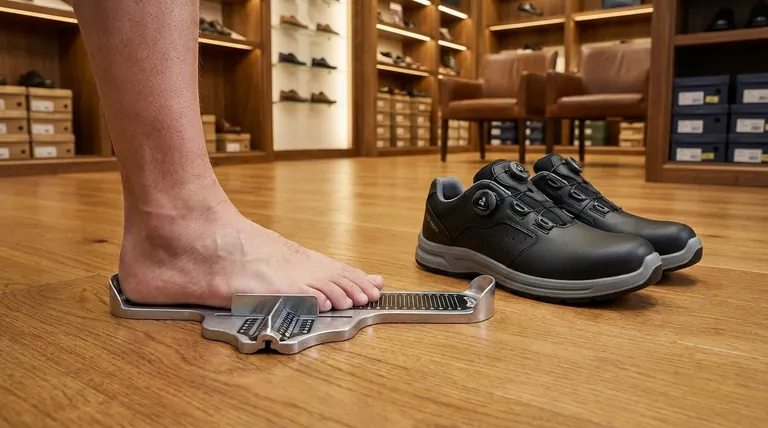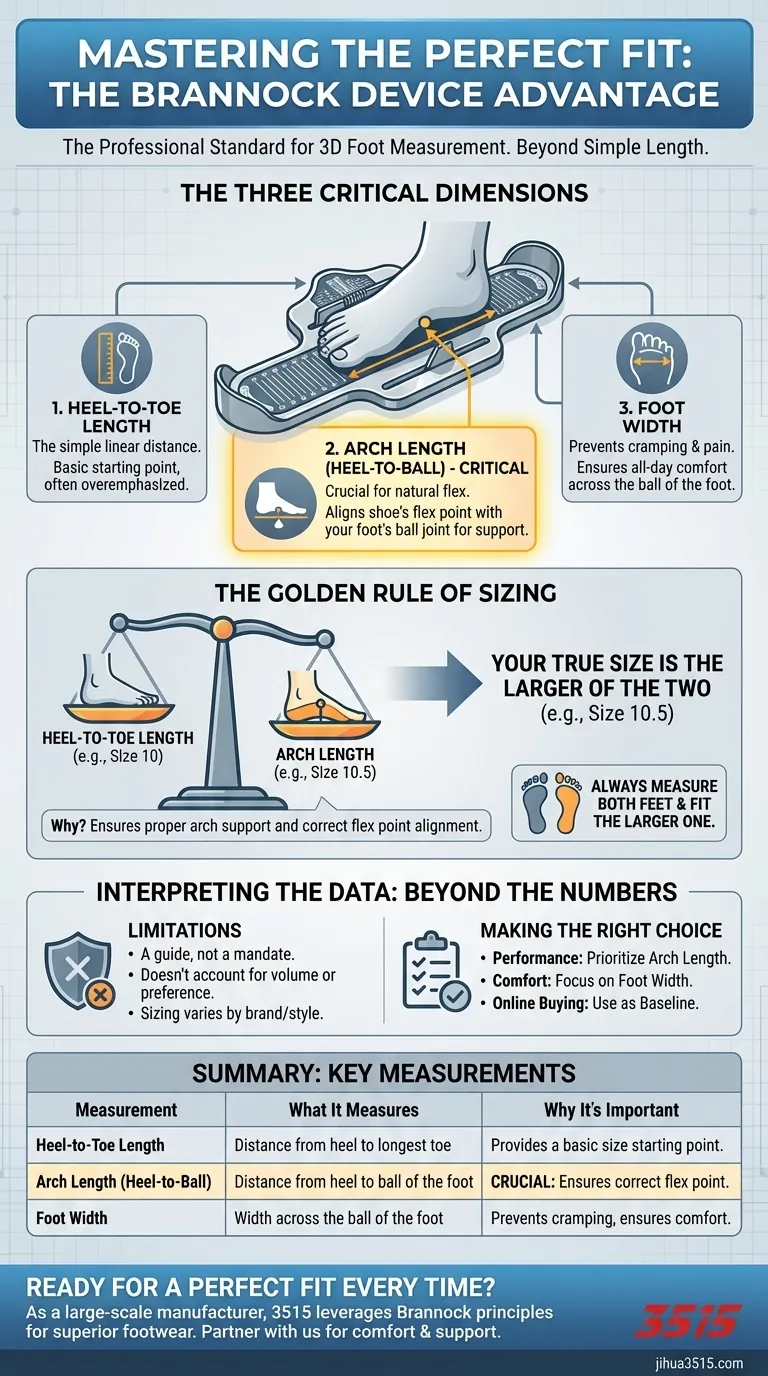A Brannock Device is the professional standard for accurately measuring your foot's true size. It is the metal or plastic measuring instrument used in high-quality shoe stores to provide a precise starting point for fitting. Unlike a simple ruler, it captures the three critical dimensions of your foot: heel-to-toe length, width, and arch length.
The most common mistake in shoe fitting is focusing only on overall length. A Brannock Device's real value is in measuring your arch length—the distance from your heel to the ball of your foot—which is the most critical factor for ensuring a shoe flexes correctly with your foot's natural movement.

Beyond Length: The Three Dimensions of a Perfect Fit
A proper shoe fit is a three-dimensional problem. Relying on just one measurement is the primary reason for discomfort and choosing the wrong size. The Brannock Device addresses this by capturing data on the three aspects of your foot that determine fit.
Measurement 1: Heel-to-Toe Length
This is the measurement most people associate with shoe size. It is the simple, linear distance from the back of your heel to the tip of your longest toe.
While this is an important data point, it is often not the one that should dictate your final shoe size.
Measurement 2: Arch Length (Heel-to-Ball)
This is the most crucial, yet most overlooked, measurement for a proper fit. The device has a dedicated pointer that slides to align with the ball joint of your big toe.
This measurement determines the distance from your heel to the widest part of your foot, which is also your foot's natural flex point. For a shoe to feel comfortable and support you correctly, its built-in flex point must align perfectly with your arch length.
Measurement 3: Foot Width
Using a sliding gauge, the device measures the width of your foot at the ball joint. This measurement corresponds to the width indicators (e.g., A, B, D, EE) associated with your length size.
Proper width is essential to prevent cramping, blisters, and nerve compression, ensuring comfort throughout the day.
How to Interpret the Measurements
The key to using the Brannock Device is knowing which measurement to prioritize. Many people have a longer arch length than their heel-to-toe length, or vice versa.
The Golden Rule of Sizing
You must compare your heel-to-toe length with your arch length. Your true, functional shoe size is the larger of these two measurements.
For example, if your longest toe measures a size 10 but your arch length measures a 10.5, you should be fitted for a size 10.5. This ensures the shoe's arch and flex point will align with your foot's anatomy, providing proper support and preventing pain.
Always Measure Both Feet
It is extremely common for a person's feet to be slightly different sizes. Always measure both feet and purchase shoes that fit the larger foot.
You can add a small insole or heel grip to the shoe for the smaller foot, but you can never comfortably make a small shoe larger.
Understanding the Limitations
The Brannock Device is an exceptional tool, but it is a starting point, not a final verdict. Understanding its limitations is key to using it effectively.
It Is a Guide, Not a Mandate
The device provides standardized data, but it cannot account for other aspects of your foot, such as instep height, overall foot volume, or personal preference for a tighter or looser fit.
Sizing Varies by Brand and Style
A size 10 in an athletic shoe from one brand will fit differently than a size 10 dress shoe from another. The construction, materials, and "last" (the form a shoe is built on) all influence the final fit.
Always use your Brannock measurement as your baseline, then confirm the fit by trying on the actual shoe. You should have about a thumb's width of space between your longest toe and the end of the shoe.
Making the Right Choice for Your Footwear
Use your Brannock measurements as an objective foundation to make informed decisions.
- If your primary focus is athletic performance: Prioritize matching your arch length to ensure the shoe's flex point aligns perfectly with your foot's biomechanics.
- If your primary focus is all-day comfort: Pay close attention to the width measurement to ensure there is no pinching or cramping at the ball of your foot.
- If your primary focus is buying shoes online: Get measured professionally once, record all three measurements for both feet, and use this data as your baseline to compare against brand-specific size charts.
Armed with your precise measurements, you can move beyond guessing and start choosing footwear that is truly engineered to fit you.
Summary Table:
| Measurement | What It Measures | Why It's Important |
|---|---|---|
| Heel-to-Toe Length | Distance from heel to longest toe | Provides a basic size starting point. |
| Arch Length (Heel-to-Ball) | Distance from heel to the ball of the foot | Crucial: Ensures the shoe flexes at the correct point for your foot. |
| Foot Width | Width across the ball of the foot | Prevents cramping, blisters, and ensures all-day comfort. |
Ready for a Perfect Fit Every Time?
As a large-scale manufacturer, 3515 produces a comprehensive range of footwear for distributors, brand owners, and bulk clients. Our production capabilities encompass all types of shoes and boots, engineered with the precise fit principles of the Brannock Device in mind.
Partner with us to provide your customers with superior comfort and support.
Contact 3515 today to discuss your footwear manufacturing needs and let us help you deliver the perfect fit.
Visual Guide

Related Products
- Advanced KPU Athletic Safety Shoe with Steel Toe Cap Anti-Slip Rotary Lacing System
- Safety Footwear Wholesale Manufacturer for Custom OEM/ODM Production
- Wholesale Safety Footwear Manufacturer for Bulk & Custom OEM Orders
- Premium Wholesale Tactical Style Safety Shoes Boots with Quick Lacing
- Wholesale Durable Breathable Safety Boots Custom OEM Manufacturer
People Also Ask
- What factors should be checked when trying on safety shoes? Ensure Perfect Fit & Maximum Protection
- What protection do work boots offer against sharp objects? Your Guide to Puncture-Resistant Footwear
- How do safety boots reduce cutting hazards? Essential Protection for Your Workforce
- What are the key safety features to consider when choosing work boots? Ensure Maximum Protection for Your Job
- What is the significance of composite or steel toe protection in work boots? Ensure Maximum Foot Safety & Comfort



















